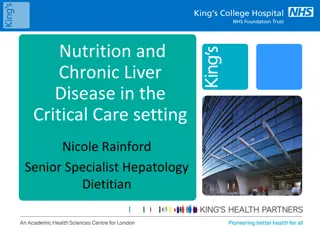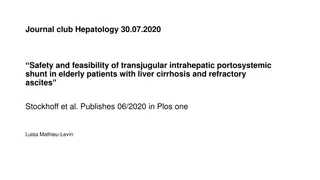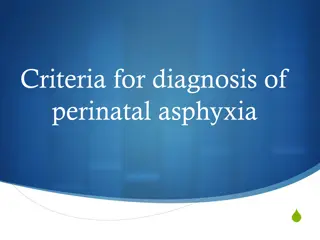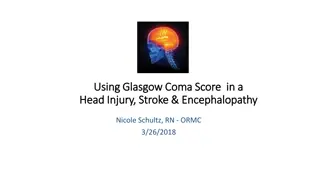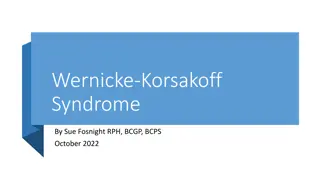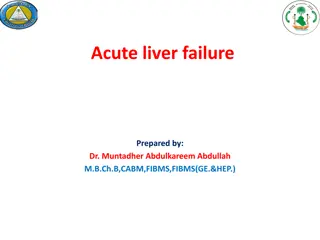Nutritional Considerations for Chronic Liver Disease in Critical Care
Malnutrition is common in chronic liver disease, leading to complications such as ascites and infections. Sarcopenia and weight loss are prevalent regardless of BMI. Critical care patients with liver disease face challenges due to limited physiological reserve, with main causes for ICU admission bei
1 views • 17 slides
Safety and Feasibility of TIPS in Elderly Patients with Liver Cirrhosis
Challenging liver cirrhosis management in elderly patients with refractory ascites has high mortality rates, and transplantation is not always viable. Transjugular intrahepatic portosystemic shunt (TIPS) serves as a non-curative treatment option, aiming to reduce portal hypertension. The procedure i
0 views • 17 slides
Diagnosis Criteria for Perinatal Asphyxia
Perinatal asphyxia refers to the interruption of oxygen supply to the fetus or newborn, leading to metabolic consequences and potential multiorgan dysfunction and long-term neurological issues. The American Academy of Pediatrics (AAP) and the American College of Obstetrics and Gynecology (ACOG) have
0 views • 12 slides
Understanding Chronic Wasting Disease (CWD)
Chronic Wasting Disease (CWD) is a transmissible spongiform encephalopathy affecting cervids and other animals. The disease was first identified in the mid-1960s and has since been a concern in wildlife populations. CWD is caused by a mutated prion protein that leads to neurological degeneration. Wh
0 views • 19 slides
Understanding Glasgow Coma Score in Head Injury, Stroke & Encephalopathy
A 61-year-old female with intractable headache and eye pain was admitted for sepsis secondary to herpes zoster, leading to encephalopathy and CO2 Narcosis. Through accurate Glasgow Coma Score (GCS) documentation, the Severity of Illness (SOI) and Risk of Mortality (ROM) were improved. Coding guideli
0 views • 7 slides
Understanding Neonatal Seizures and Their Pathophysiology
Neonatal seizures are sudden changes in neurologic function of a newborn, involving motor, behavior, and autonomic functions. The pathophysiology includes delays in Na/K ATPase maturation, increased receptor density, and GABAergic transmission. Different types of seizures like subtle, clonic, tonic,
1 views • 24 slides
Understanding Wernicke-Korsakoff Syndrome: Overview and Clinical Considerations
Wernicke-Korsakoff Syndrome (WKS) comprises Wernicke's Encephalopathy (WE) and Korsakoff Syndrome. WE presents with altered mental status, ocular signs, and ataxia, while Korsakoff Syndrome manifests as amnesia and confabulations. Untreated WE can progress to Korsakoff Syndrome in about 80% of cases
0 views • 52 slides
Understanding Prion Diseases: A Comprehensive Overview
Prion diseases, such as Transmissible Spongiform Encephalopathies (TSEs), are rare and fatal neurological disorders affecting both humans and animals. These diseases are characterized by long incubation periods, neuronal loss, and the absence of an inflammatory response. Caused by abnormal folding o
0 views • 12 slides
Understanding Bovine Spongiform Encephalopathy (BSE) - The Mad Cow Disease
Subacute or chronic fatal neurodegenerative disease in adult cattle, Bovine Spongiform Encephalopathy (BSE) is a transmissible spongiform encephalopathy with spongy degeneration in the CNS. It is caused by an infectious protein called prion and is mostly found in Europe, with potential zoonotic impa
0 views • 22 slides
Overview of Acute Liver Failure: Causes, Classification, and Diagnosis
Acute liver failure is a severe condition characterized by rapid liver dysfunction within 6 months of symptom onset, leading to encephalopathy, coagulopathy, and jaundice. This condition can be classified as hyperacute, acute, subacute, fulminant, or sub-fulminant based on the duration from jaundice
0 views • 16 slides
